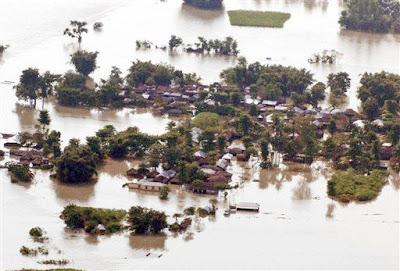I was thinking of blogging on this topic earlier but was unable to find a balanced analysis of the causes behind the tragedy. The political leaders were busy in blame game while villages after villages both in Nepal and India, were being overwhelmed by the Kosi river. Some attribute the flooding, which killed hundreds of people and left millions homeless and forced people to shift to high altitudes, to natural factors. But, Gywali argues that this was a man-made tragedy; it is a product of poor planning and corruption.
The Kosi acts as a massive conveyor belt taking sediment from the Himalaya to the Bay of Bengal. Some one hundred million cubic meters of gravel, sand and mud flow out of the Chatara gorge in mountainous Nepal every year. This flow cannot be blamed on deforestation: we have more forest cover in the Kosi catchment today than ever before. It is caused by Himalayan geotectonics coupled with the monsoon regime. As the river slows down in the flat plains beyond, it deposits its sediment, filling up the river's main channel until it overflows and begins a new course. This natural process produced the large inland delta that lies across southern Nepal and the Indian state of Bihar.
But, for the last half century, the 'Kosi Project' has used embankments to restrict the river's course. This has kept sediment deposits within the main canal, perching the river some four meters above the surrounding land. It was a disaster waiting to happen. Indiscriminate embankment building could never hold back the Kosi's sediment. The river flow at the time of last month's breach was not even high. Rather, it was lower than the minimum average flow for August.
...an Indian scholar writing in Bombay's Economic and Political Weekly, estimated that as much as 60 per cent of the 2.5–3 billion rupees spent annually by the Bihar government on construction and repair works was pocketed by politicians, contractors and engineers. It is said there is a perfect system of percentages in which a share exists for everyone who matters, from the minister to the junior engineer. The actual expenditure never exceeds 30 per cent of the budgeted cost. Contractor's bills are paid without being verified — many of the desiltation and maintenance works allegedly completed are never done at all, and yet payments are made.
